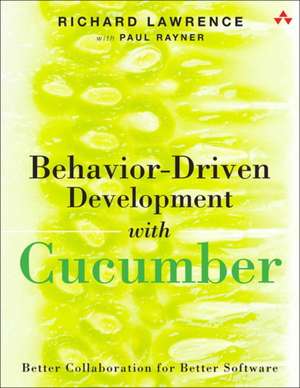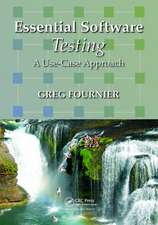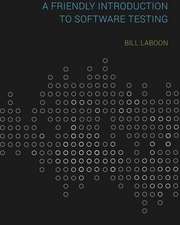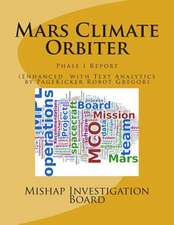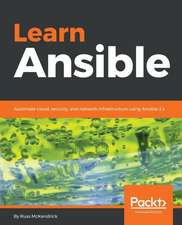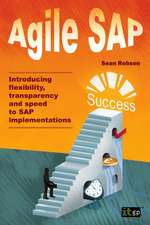Behavior-Driven Development with Cucumber
Autor Richard Lawrence, Paul Rayneren Limba Engleză Paperback – 8 mar 2016
Preț: 169.97 lei
Preț vechi: 212.47 lei
-20% Nou
32.52€ • 33.96$ • 26.92£
Carte disponibilă
Livrare economică 14-28 martie
Livrare express 28 februarie-06 martie pentru 22.70 lei
Specificații
ISBN-10: 0321772636
Pagini: 336
Dimensiuni: 178 x 229 x 12 mm
Greutate: 0.34 kg
Editura: Addison-Wesley Professional
Cuprins
Chapter 1: Focusing on Value
When Scrum Isn't Enough
Finding a High-Value Feature to Start With
Before You Start with Cucumber
Finding the First MMF
Slicing an MMF into User Stories
Summary
Reference
Chapter 2: Exploring with Examples
BDD Is a Cooperative Game
BDD Is a Whole Team Thing
Allow Time and Space to Learn
Flesh Out the Happy Path First
Use Real Examples
Example Mapping Gives the Discussion Structure
Optimizing for Discovery
Addressing Some Concerns
Treat Resistance as a Resource
Playing the BDD Game
Opening
Exploring
Closing
Summary
References
Chapter 3: Formalizing Examples into Scenarios
Moving from Examples to Scenarios
Feature Files as Collaboration Points
BDD Is Iterative, Not Linear
Finding the Meaningful Variations
Gherkin: A Language for Expressive Scenarios
Summary
Resources
Chapter 4: Automating Examples
The Test Automation Stack
Adjusting to Working Test-First
Annotating Element Names in Mockups
How Does User Experience Design Fit In to This?
Did They Really Just Hard Code Those Results?
Anatomy of a Step Definition
Simple Cucumber Expressions
Regular Expressions
Anchors
Wildcards and Quantifiers
Capturing and Not Capturing
Just Enough
Custom Cucumber Expressions Parameter Types
Beyond Ruby
Slow Is Normal (at First)
Choose Cucumber Based on Audience, Not Scope
Summary
Chapter 5: Frequent Delivery and Visibility
How BDD Changes the Tester's Role
Exploratory Testing
BDD and Automated Builds
Faster Stakeholder Feedback
How Getting to Done More Often Changes All Sorts of Things
Frequent Visibility and Legacy Systems
Documentation: Integrated and Living
Avoiding Mini-Waterfalls and Making the Change Stick
Summary
References
Chapter 6: Making Scenarios More Expressive
Feedback About Scenarios
How to Make Your Scenarios More Expressive
Finding the Right Level of Abstraction
Including the Appropriate Details
Expressive Language in the Steps
Refactoring Scenarios
Good Scenario Titles
Summary
References
Chapter 7: Growing Living Documentation
What Is Living Documentation and Why Is It Better?
Cucumber Features and Other Documentation
Avoid Gherkin in User Story Descriptions
The Unexpected Relationship Between Cucumber Features and User Stories
Stable Scenarios
Growing and Splitting Features
Split When Backgrounds Diverge
Split When a New Domain Concept Emerges
Secondary Organization Using Tags
Structure Is Emergent
Summary
Chapter 8: Succeeding with Scenario Data
Characteristics of Good Scenarios
Independent
Repeatable
Researchable
Realistic
Robust
Maintainable
Fast
Sharing Data
When to Share Data
Raising the Level of Abstraction with Data Personas
Data Cleanup
Summary
Reference
Chapter 9: Conclusion
9780321772633 TOC 4/22/2019
Notă biografică
Richard Lawrence is co-owner of the consulting firm Agile For All. He trains and coaches people to collaborate more effectively with other people to solve complex, meaningful problems. He draws on a diverse background in software development, engineering, anthropology, and political science.
Richard was an early adopter of behavior-driven development and led the development of the first .NET version of Cucumber, Cuke4Nuke. He is a popular speaker at conferences on BDD and Agile software development.
Paul Rayner co-founded and co-leads DDD Denver. He regularly speaks at local user groups and at regional and international conferences. If you are looking for an expert hands-on team coach and design mentor in domain-driven design (DDD), BDD with Cucumber, or lean/agile processes, Paul is available for consulting and training through his company, Virtual Genius LLC.
